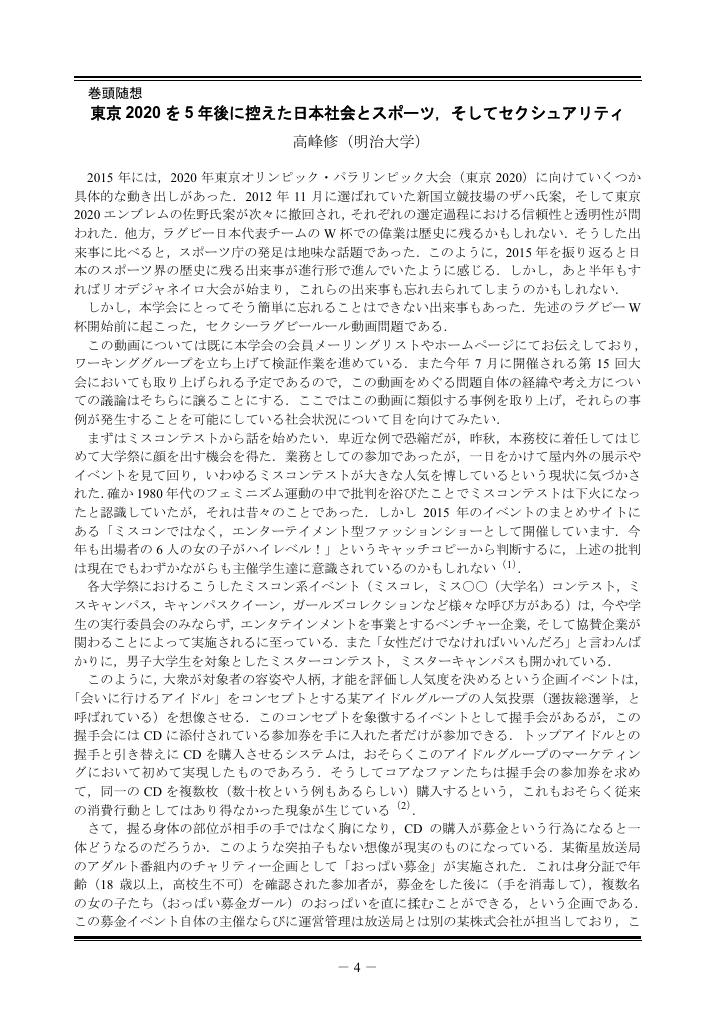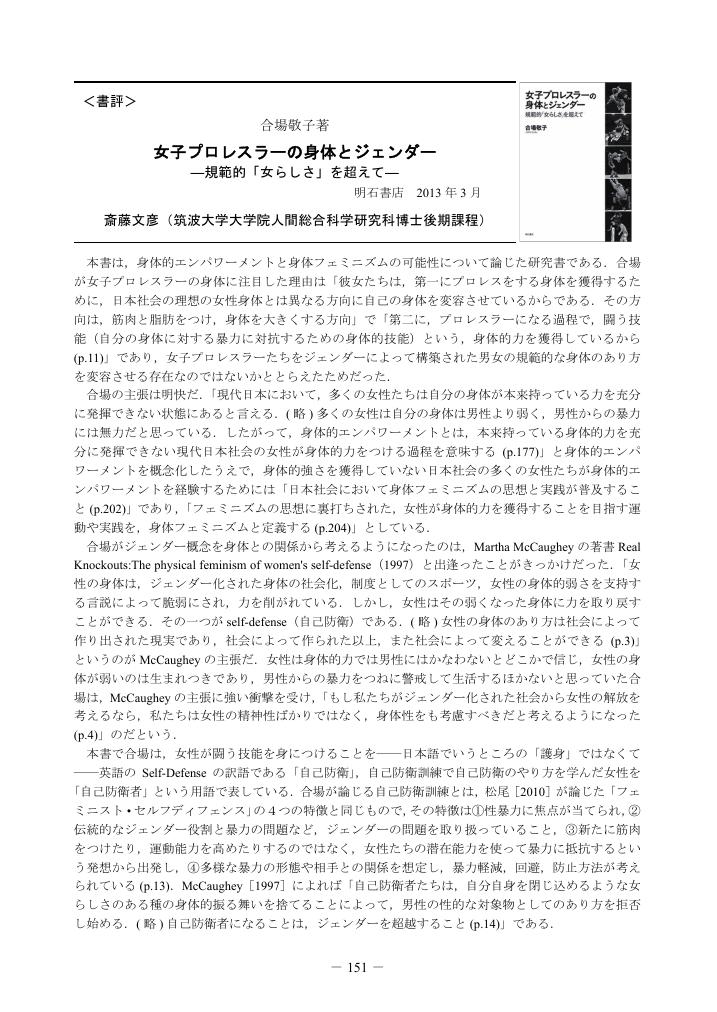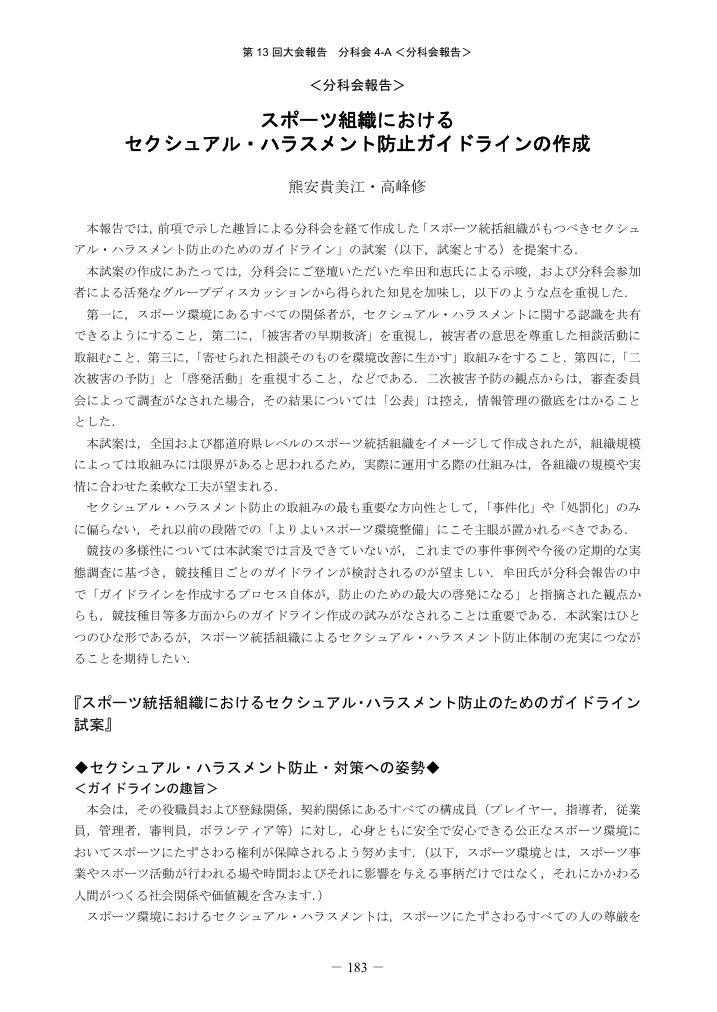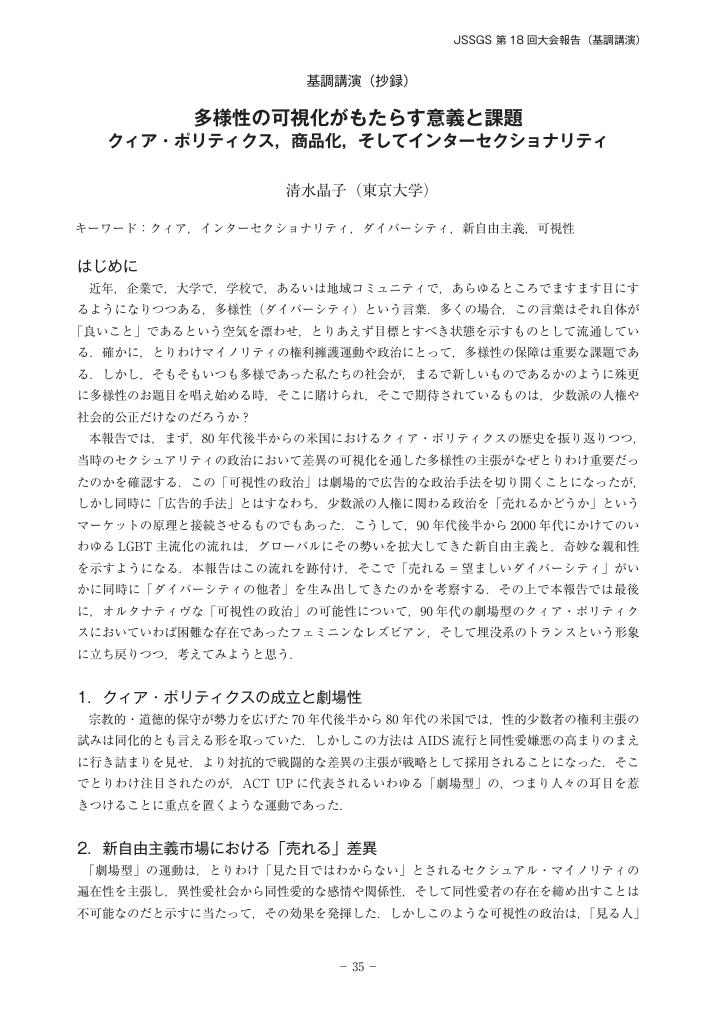- 著者
- 関 めぐみ
- 出版者
- 日本スポーツとジェンダー学会
- 雑誌
- スポーツとジェンダー研究 (ISSN:13482157)
- 巻号頁・発行日
- vol.12, pp.19-30, 2014
The purpose of this study is to show how the growing number of minorities in the organization affects their participation in the decision-making process. In this study, I will focus on all-male college football teams in Japan, specifically examining the role of women who work as joshi manêjâ (girl managers). In Japan, a manêjâ is a student who is in charge of the sports equipment and records of their school sports team. At the present time, the majority of manêjâ are women.The methods of data collection employed include participant observations, interviews and content analysis. The research was based on data collected from two college football teams. The first fieldwork consisted of observing and interviewing members of Team X. This research was conducted between March and December of 2011. The percentage of females was 27%. The second fieldwork was conducted between May and December 2012. The percentage of females was 39.6% for Team Y. Results obtained by comparing Team X to Team Y indicate that the duties and responsibilities of joshi manêjâ increased when the number of joshi manêjâ remained above 30% of the team. In the past, socializing between male and female members of the club was prohibited. However, as the number of joshi manêjâs increased, pressure to socialize with the male players also increased. In fact, pressure to perform menial tasks and to socialize with male players led several joshi manêjâs to quit working for their teams.Therefore, despite the growing number of female within the club, socializing between the female and the male players had in fact strengthened and maintained the dominant power of the male players.
2 0 0 0 OA 体育離れのジェンダー・ポリティクス 当事者へのインタビュー調査から
- 著者
- 井谷 惠子 井谷 聡子 関 めぐみ 三上 純
- 出版者
- 日本スポーツとジェンダー学会
- 雑誌
- スポーツとジェンダー研究 (ISSN:13482157)
- 巻号頁・発行日
- vol.17, pp.6-20, 2019 (Released:2019-09-06)
- 参考文献数
- 11
This study examines the gender politics in physical education curriculum that influence students to disengage from physical education and sport. For the analysis, we selected five students among survey respondents who identified as cis-gendered heterosexual women and conducted semi-structured interviews. The grounded theory approach (GTA) was utilized and MAXQDA Analytics Pro2018 was used to assist the analysis. The analysis generated nine primary categories, for example; “visibility”, “physical education curriculum”, and “characteristics of exercise”. It also generated forty-nine sub-categories. The relationships among categories indicate a “negative spiral” in which “poor exercise experience”, “low physical skill and strength”, “negative experience” and “negative emotional reaction” formed a chain relationship. Central to physical education curriculum is the focus on modern sports that has been developed as a tool to educate men. Such physical education is characterized by athleticism, record setting, hierarchy, and winning, as well as physical performance. The space of physical education is saturated with value orientation based on high performance. In such space, participants have had negative experiences in which their poor skills and physical weakness were exposed to their peers. They also expressed discomfort that physical education leaves little space for values outside of physical performance to be recognized.
2 0 0 0 OA 山本雄二著『ブルマーの謎 ―<女子の身体>と戦後日本―』
- 著者
- 鈴木 楓太
- 出版者
- 日本スポーツとジェンダー学会
- 雑誌
- スポーツとジェンダー研究 (ISSN:13482157)
- 巻号頁・発行日
- vol.15, pp.107-109, 2017 (Released:2017-12-10)
- 参考文献数
- 2
2 0 0 0 OA 東京2020を5年後に控えた日本社会とスポーツ,そしてセクシュアリティ
- 著者
- 高峰 修
- 出版者
- 日本スポーツとジェンダー学会
- 雑誌
- スポーツとジェンダー研究 (ISSN:13482157)
- 巻号頁・発行日
- vol.14, pp.4-5, 2016 (Released:2017-04-25)
- 参考文献数
- 6
- 著者
- 小林 直美
- 出版者
- 日本スポーツとジェンダー学会
- 雑誌
- スポーツとジェンダー研究 (ISSN:13482157)
- 巻号頁・発行日
- vol.20, pp.108-111, 2022 (Released:2022-11-20)
1 0 0 0 OA スポーツにおける「対等」なジェンダー関係のために 競艇に見る「スポーツ」と「ジェンダー」
- 著者
- 藤山 新
- 出版者
- 日本スポーツとジェンダー学会
- 雑誌
- スポーツとジェンダー研究 (ISSN:13482157)
- 巻号頁・発行日
- vol.1, pp.15-26, 2003 (Released:2023-06-23)
- 参考文献数
- 8
This paper discusses gender relations in the context of boat racing in which both male and female players compete together. This situation is used as an example of partially equal gender relations, as seen by post-structuralism gender theory. This theory perceives the physical sexual differences between men and women as being created differences. Even in this situation where mixed competition is achieved, gender differences still exist. Examples include regarding physical sexual differences between males and females as being absolute differences, the system in which the women's league competition is separated from the mainstream boat races, and the tendency of the media to feature female players in a manner unrelated to the actual racing. In short, there is no system that assures the equality and fairness of the results. Therefore, gender equality in the form of mixed competition does not necessarily assure equal gender relations in other areas. In order to establish equal gender relations in sport, at least gender-based differences in participations in competitions must be eliminated, and a system to maintain the equality and fairness of competition results must be established. The issue of treating all players equally, regardless of gender, remains to be resolved in each competitive sporting arena.
- 著者
- 高峰 修 飯田 貴子 井谷 惠子 太田 あや子 熊安 貴美江 吉川 康夫
- 出版者
- 日本スポーツとジェンダー学会
- 雑誌
- スポーツとジェンダー研究 (ISSN:13482157)
- 巻号頁・発行日
- vol.7, pp.16-28, 2009 (Released:2023-06-28)
- 参考文献数
- 5
- 被引用文献数
- 1
The purpose of this study is to examine the relationships among items of sexual harassment (SH) experienced by female Japanese college students inside of sport settings. Respondents were asked to answer whether or not they had experienced as SH 19 specific male behaviors toward female college students inside of sport settings. Data was collected by questionnaire. The survey was addressed to 4,208 students at 23 colleges, from June to November, 2003, and in October, 2006, and 3,989 students responded. Nine hundred ninety eight female students belonging to intercollegiate athletic clubs, and 477 female students belonging to intramural sport clubs were available for statistical analysis in this study. The experiences of SH inside of sport settings were first compared with respect to two types of sport clubs. Female students reported that they had been physically touched or massaged, or had been told jokes of a sexual nature. Among members of intercollegiate clubs, the percentage of persons who perceived “physical touching” behavior as SH was lower than that among members of intramural clubs. Intercollegiate club members reported their harassers to be instructors employed from outside their universities, while intramural club members reported them to be faculty members and upperclassmen in their clubs. Many female students reported that, when they experienced SH behavior inside sport settings, they shrugged of the behavior, did nothing, or were unable to do anything. Logistic regression analyses were conducted to examine the structure of behavior experienced as SH. Among intercollegiate athletic club members, “persistent sexual advances” as a dependent variable was significantly explained by three variables: “ask female students out to dinner or on a date,” “send e-mail with sexual content,” and “give female students a back/shoulder massage while giving instructions,” while among intramural club members, only “make female students serve tea or perform personal tasks” significantly explained “persistent sexual advances.” Finally, the importance of considering the structure of experienced SH items is discussed.
1 0 0 0 OA 合場敬子著 女子プロレスラーの身体とジェンダー 規範的「女らしさ」を超えて
- 著者
- 斎藤 文彦
- 出版者
- 日本スポーツとジェンダー学会
- 雑誌
- スポーツとジェンダー研究 (ISSN:13482157)
- 巻号頁・発行日
- vol.12, pp.151-152, 2014 (Released:2017-04-28)
1 0 0 0 OA スポーツ組織における セクシュアル・ハラスメント防止ガイドラインの作成
- 著者
- 熊安 貴美江 高峰 修
- 出版者
- 日本スポーツとジェンダー学会
- 雑誌
- スポーツとジェンダー研究 (ISSN:13482157)
- 巻号頁・発行日
- vol.13, pp.183-192, 2015 (Released:2017-04-14)
- 参考文献数
- 4
- 被引用文献数
- 1
1 0 0 0 OA 体育におけるヘゲモニックな男性性の構築 「体育嫌い」の男性の声から
- 著者
- 三上 純 井谷 惠子 関 めぐみ 井谷 聡子
- 出版者
- 日本スポーツとジェンダー学会
- 雑誌
- スポーツとジェンダー研究 (ISSN:13482157)
- 巻号頁・発行日
- vol.20, pp.20-35, 2022 (Released:2022-11-20)
- 参考文献数
- 21
The purpose of this study is to analyze the process of struggles among masculinities for hegemony, based on the narratives of men who had a sense of aversion to physical education and to examine how the hegemonic masculinity constructed as a result of struggle may legitimatize unequal gender relations in PE. In this study, focus group interviews were conducted with ten university students who expressed the dislikes of PE. For the purpose of this paper, we focus on the narratives of five cisgender, heterosexual men. The analysis revealed that the participants had negative experiences in PE because sports, which emphasize competition, are placed at the center of the learning contents. In addition, in such PE classes, educational practices are often based on the assumption that " men are good at sports and physical activities ", and PE teachers tend to be tough on students who are not good at sports. Regarding the relationship among students, participants talked about the ways in which hierarchy among men are based on motor skills demonstrated in PE classes and it directly related to the hierarchy in school life outside of PE classes. Moreover, the richness of heterosexual experiences was also a part of the hegemonic masculinity in PE defined by the high level of motor skills. Additionally, we examined the effects of hegemonic struggle between masculinities on participants’ body, and how they survived the difficult hierarchical positions they were placed. The result shows that participants’ difficult situation was created by the connection between athleticism and masculinity. Therefore, we argued that it is necessary to seek the ways to separate sports from masculinity, and to reconsider if it is appropriate to place competitive sport at the center of PE curriculum.
1 0 0 0 OA 女性割合の増加とジェンダー秩序の変化 大学アメフト部における女性スタッフの権力に着目して
- 著者
- 関 めぐみ
- 出版者
- 日本スポーツとジェンダー学会
- 雑誌
- スポーツとジェンダー研究 (ISSN:13482157)
- 巻号頁・発行日
- vol.12, pp.19-30, 2014 (Released:2017-04-28)
- 参考文献数
- 17
The purpose of this study is to show how the growing number of minorities in the organization affects their participation in the decision-making process. In this study, I will focus on all-male college football teams in Japan, specifically examining the role of women who work as joshi manêjâ (girl managers). In Japan, a manêjâ is a student who is in charge of the sports equipment and records of their school sports team. At the present time, the majority of manêjâ are women. The methods of data collection employed include participant observations, interviews and content analysis. The research was based on data collected from two college football teams. The first fieldwork consisted of observing and interviewing members of Team X. This research was conducted between March and December of 2011. The percentage of females was 27%. The second fieldwork was conducted between May and December 2012. The percentage of females was 39.6% for Team Y. Results obtained by comparing Team X to Team Y indicate that the duties and responsibilities of joshi manêjâ increased when the number of joshi manêjâ remained above 30% of the team. In the past, socializing between male and female members of the club was prohibited. However, as the number of joshi manêjâs increased, pressure to socialize with the male players also increased. In fact, pressure to perform menial tasks and to socialize with male players led several joshi manêjâs to quit working for their teams. Therefore, despite the growing number of female within the club, socializing between the female and the male players had in fact strengthened and maintained the dominant power of the male players.
1 0 0 0 OA IOC ジェンダー平等とインクルージョン目標2021-2024
- 著者
- 來田 享子 田原 淳子
- 出版者
- 日本スポーツとジェンダー学会
- 雑誌
- スポーツとジェンダー研究 (ISSN:13482157)
- 巻号頁・発行日
- vol.20, pp.112-116, 2022 (Released:2022-11-20)
1 0 0 0 OA スポーツの高度化による排除 メディアや選手の役割と課題
- 著者
- 後藤 太輔
- 出版者
- 日本スポーツとジェンダー学会
- 雑誌
- スポーツとジェンダー研究 (ISSN:13482157)
- 巻号頁・発行日
- vol.18, pp.41-42, 2020 (Released:2020-09-30)
1 0 0 0 OA 柔道における昇段資格の男女差
- 著者
- 中込 常昭
- 出版者
- 日本スポーツとジェンダー学会
- 雑誌
- スポーツとジェンダー研究 (ISSN:13482157)
- 巻号頁・発行日
- vol.4, pp.16-22, 2006 (Released:2021-03-31)
- 参考文献数
- 10
- 著者
- 清水 晶子
- 出版者
- 日本スポーツとジェンダー学会
- 雑誌
- スポーツとジェンダー研究 (ISSN:13482157)
- 巻号頁・発行日
- vol.18, pp.35-36, 2020 (Released:2020-09-30)
- 著者
- 高峰 修
- 出版者
- 日本スポーツとジェンダー学会
- 雑誌
- スポーツとジェンダー研究 (ISSN:13482157)
- 巻号頁・発行日
- vol.17, pp.87-102, 2019
1 0 0 0 OA 文部科学省の性的マイノリティへの取り組みについて
- 著者
- 風間 孝
- 出版者
- 日本スポーツとジェンダー学会
- 雑誌
- スポーツとジェンダー研究 (ISSN:13482157)
- 巻号頁・発行日
- vol.16, pp.127-129, 2018 (Released:2018-12-29)
- 著者
- 井谷 聡子
- 出版者
- 日本スポーツとジェンダー学会
- 雑誌
- スポーツとジェンダー研究 (ISSN:13482157)
- 巻号頁・発行日
- vol.14, pp.169-171, 2016 (Released:2017-04-25)
- 著者
- 高峰 修
- 出版者
- 日本スポーツとジェンダー学会
- 雑誌
- スポーツとジェンダー研究 (ISSN:13482157)
- 巻号頁・発行日
- vol.14, pp.146-168, 2016 (Released:2017-04-25)
- 参考文献数
- 4
- 著者
- 大勝 志津穂
- 出版者
- 日本スポーツとジェンダー学会
- 雑誌
- スポーツとジェンダー研究 (ISSN:13482157)
- 巻号頁・発行日
- vol.19, pp.8-18, 2021 (Released:2021-10-09)
- 参考文献数
- 10
This study explores the changes in the exercising and sports of individuals before and after COVID-19 through a secondary analysis of data from “National Survey on the Effects of COVID-19 on Sports and Physical Activities” conducted by the Sasakawa Sports Foundation’s. This study particularly focuses on gender and on living with or without children to examine changes in the rates and frequencies for exercising and sports. This study also examines the relations between the changes in the use of time in daily lives and state of mind, and the level of involvement in exercising and sports. The analysis demonstrates that women are more adversely affected than men in the practice rates and frequencies of exercising and sports. Regarding the changes in the use of time in daily life and the state of mind, women are more affected than men. In particular, women who live with children are more affected than men living with or without children, or women who live without children. The rates of exercising and sports of those who experienced changes in their use of time decreased among those who “spend less time on housework, childcare or elderly care,” “spend less time alone,” “spend less leisure time,” and “spend more time with their family members.” By gender, the women’s exercising and sports rates decreased more than men. Regarding the changes in exercising and sports of those who experienced changes in their state of mind showed a more significant decrease among women than men in many survey items, regardless of experiencing negative or positive changes. The government and related organizations also need to further investigate the current situation and consider measures to enable all people to be involved in exercising and sports by when the COVID-19 pandemic is under control.











